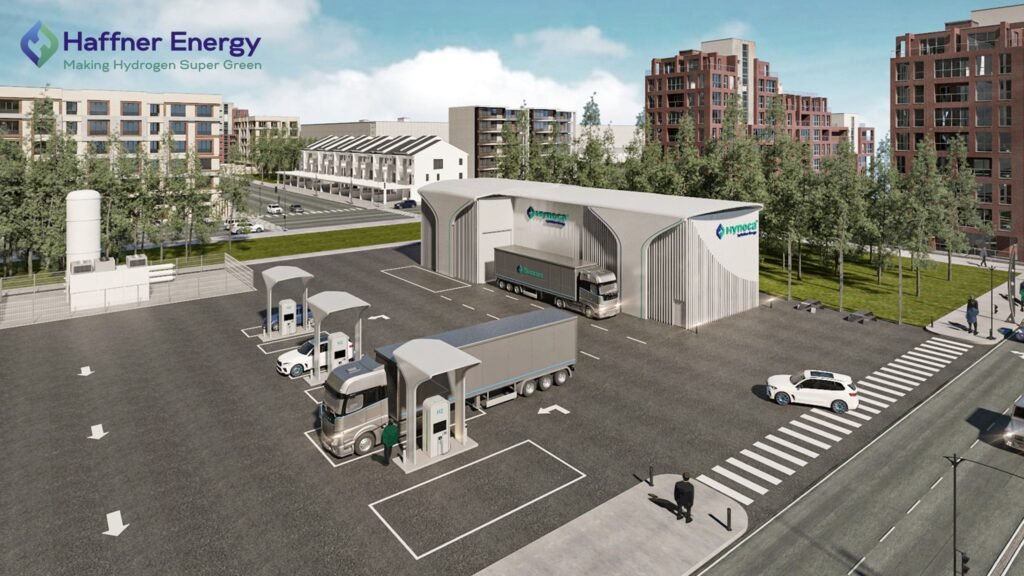The thermolysis of biomass allows the production of green hydrogen and biochar. Around this CO emission technology2 negative, Haffner Energy supports a territorial circular approach with mobility use of locally produced hydrogen, which allows ecological, energy and economic performance.
An alternative to electrolysis to produce green hydrogen, thermolysis is a process for producing hydrogen from biological waste, forest co-products, sawdust, miscanthus and biomass containing 10 to 30% humidity. These deposits are complementary to those used in methanization. The principle is to thermally break the molecules of this biomass and separate the hydrogen it contains.
Hydrogen production and carbon sequestration
“We have been transforming biomass into energy for 25 years,” explains Christian Bestien, Business Development director. We have worked for more than 10 years to develop the Hynoca process, which means “Hydrogen No Carbon”. This process produces hydrogen on one side and biochar on the other. This last carbon compound is a real carbon sink since, for 1 kg of hydrogen produced, we sequester 12 kg of CO2. This is the exact opposite of producing hydrogen from gas, which emits 12 kg of CO2 per kilo of hydrogen produced! » Biochar is a valuable compound for agriculture, as well as a permanent stock of carbon. It helps improve the structure of the soil which, as a result, better retains water, essential in periods of drought. As an agricultural amendment, it helps improve yields and reduce the importation and dependence of chemical fertilizers, the costs of which have exploded, for farmers.
Energy profitability
“Thirty tonnes of biomass allows us to produce around 1 tonne of hydrogen and 5.5 tonnes of biochar, with an overall energy yield of 70 to 80%. Our process is in fact autothermal, which means that there is no need for energy input for its operation, except at start-up. Electrolysis does not make it possible to obtain a negative carbon footprint, because there is no storage of CO2but also because it consumes a lot of electricity whose peak production is carbon-based (gas, coal). Hynoca requires only 10% of the electrical energy needed by an electrolyzer to produce the same quantity of hydrogen! The explosion in electricity prices and the strong demands for this energy are reducing the interest in electrolysis, apart of course from intermittent production (wind, solar), for which storage or direct use is difficult. »
“The deployment of our process in the region is also an opportunity for the French agricultural and forestry sector. Thermolysis creates new uses for large volumes of woody co-products that have not yet been recovered (wood damaged by fires, attacked by bark beetles), but also bark, flax shives, miscanthus which can grow on soils with very low agricultural interest. It can use all intermediate sizes of wood, thus providing income (and jobs) for forest operators who will thus be able to maintain their forests even better. We also work on recycled wood. Hynoca makes it possible with 1 ha of miscanthus to produce energy 10 times greater than that provided by 1 ha of rapeseed transformed into biofuel, which will therefore make it possible to travel 10 times more kilometers with the same surface area of soil! »
Circular economy, local mobility
“We produce hydrogen and consume it on site”, this is the logic for deploying hydrogen production at Haffner Energy, which is part of a circular economy approach. In fact, the materials are collected within a radius of 50 to 100 km. Then Haffner Energy recommends local use of the energy produced for mobility and/or for industrial uses. “This avoids the difficulties and energy consumption required for transport and distribution. It is in fact more economical to transport biomass than hydrogen: it requires four times fewer trucks. » At current energy prices, this is a significant gain. This is why Haffner Energy combines hydrogen filling stations with production. “Since our IPO in February 2022, several large industrialists and investors have bet on our technology by entering our capital: HRS for hydrogen distribution stations, the cement manufacturer Vicat for interest in industrial use, Eren who can promote our international development, our model being reproducible in many countries, such as the United States which also have very significant dry biomass resources. »
“The size of our units is therefore adapted to local hydrogen consumption needs. As an indication, an average service station distributing fossil fuels corresponds to a production capacity of 2 tonnes of hydrogen per day. Our Hynoca units for mobility have a capacity of 700 kg to 3,000 kg/day. With our modular-sized units, our objective is to quickly establish with local stakeholders a local network of distribution stations on a territorial scale which will allow a real deployment of hydrogen mobility use, creating local jobs and resources. »
Projects in deployment
“Since the latest developments in the Russian-Ukrainian crisis, we have been contacted daily by new industrialists, communities and mobility players seeking to escape their dependence on gas. The energy policy cards are clearly being reshuffled. All-electric has its limits. With Hynoca, we are tapping into another source, with an acceptable production cost. We are therefore currently carrying out numerous projects with partners on national territory, but also in Switzerland, the Netherlands and the United States, to move towards more energy independence. Let us cite for example our project with the Thevenin and Ducrot group, which operates more than 400 Avia service stations in Eastern France and with Ets Roussel, biomass collectors, with whom we will build a combined production/station site. hydrogen in Allier. We are targeting several hundred Hynoca modules by 2025. With biomass, we could cover 10% of the overall mobility need. Our green production solution without electricity easily adapts to each territory. »

